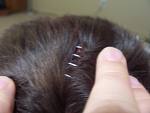
{ 4 comments }

{ 4 comments }
When the ER gets busy, we need to rush things a bit to keep the patients moving. Ordinarily, this is not a big deal, but occasionally things can be overlooked. Years ago, a patient came in with a narcotic overdose on just such a busy day. His wife suspected that he was addicted to pain medications and had been trying to keep it a secret. She also thought that he had gotten hold of some  from a relative. These patches release potent narcotics gradually into the bloodstream. Hmm. He was pretty sleepy when he came in, and his pupils were small, consistent with a narcotic overdose, but he didn’t have any patches on his body. He needed to be admitted because of his poor mental status, so those arrangements were made. Later on, the admitting nurse called down to the ER to report that she had found a fentanyl patch. It had been placed carefully underneath his scrotum, where his wife was unlikely to spot it. Fooled us too.
from a relative. These patches release potent narcotics gradually into the bloodstream. Hmm. He was pretty sleepy when he came in, and his pupils were small, consistent with a narcotic overdose, but he didn’t have any patches on his body. He needed to be admitted because of his poor mental status, so those arrangements were made. Later on, the admitting nurse called down to the ER to report that she had found a fentanyl patch. It had been placed carefully underneath his scrotum, where his wife was unlikely to spot it. Fooled us too.
{ 5 comments }
Welcome to another installment of the Top 10 Ways to Avoid the ER.
 Number 6 – Opt for comfort care
{ 2 comments }
Q:
Dear Your ER Doc:
I have seen you write about the dangers of carbon monoxide poisoning before. I recently read an article where victim’s were taken to a hospital that had specialized facilities for treating this condition. Can you explain what these are and if they are common at most hospitals?
A:
Carbon Monoxide poisoning is usually treated by high-flow (100%) oxygen. All hospitals have the capability for administering oxygen to patients who have been exposed to carbon monoxide. Occasionally, severe cases of carbon monoxide poisoning are treated in Hyperbaric chambers.

Patients can be placed in these chambers where they can breath oxygen that is at higher than atmospheric pressure. Most hospitals do not have hyperbaric chambers, but patients may be transferred to a hyperbaric center if necessary.
{ 4 comments }
 In a new, landmark study in the New England Journal of Medicine, medical doctors in England were determined to have substandard IQ’s.
In a new, landmark study in the New England Journal of Medicine, medical doctors in England were determined to have substandard IQ’s.
According to Niles Schmitty, MD, the study’s lead author, “Most British docs are basically as dumb as a box of rocks.” Thanks for the heads up Dr. Schmitty.
{ 3 comments }